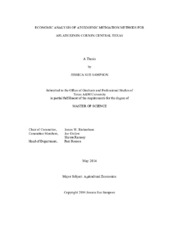| dc.description.abstract | Atoxigenics and crop insurance are available to producers to assist in preventing economic loss from aflatoxin contamination in corn. Atoxigenics are a newer technology available to farmers, and although professional opinion of this biotechnology encourages its use, an economic analysis has not been performed to determine if the atoxigenics are overall economically beneficial to the producer when combined with crop insurance.
The objective of this paper is to perform an economic analysis on the decision to use available atoxigenic treatments on a corn crop, and evaluate the economic outcome at different crop insurance levels for corn producers in Central Texas. This paper will use a risk based partial budget simulation model combined with an aflatoxin contamination simulation model to complete a risk analysis on the decision to use atoxigenic mitigation methods. Field level data on aflatoxin contamination levels is from Bell County, Texas.
A representative farm was simulated with and without atoxigenic treatments and each case was simulated across a range of crop insurance options available to corn producers in Bell County. A total of 50 scenarios were simulated and compared based on net revenue.
Results show atoxigenics do provide a monetary benefit to producers. When the atoxigenic treatment was compared to no atoxigenic treatment, both with no insurance, the simulated average net revenue was higher by $8-$10 per acre for the treatment scenario. When crop insurance was simulated, with and without atoxigenic treatments, results indicated the current RMA insurance premiums were too high for treatment scenarios. The current RMA premiums did not account for the decreased risk of insurance payout amount and frequency associated with the use of atoxigenics.
Current RMA premiums were replaced with fair premiums equal to the simulated mean indemnity payment for all crop insurance options. When the treatment scenario was compared to the no treatment scenario, under the set of most efficient crop insurance options, atoxigenic treatment provided the producer with an additional net monetary benefit of $8-$16 per acre. | en |


